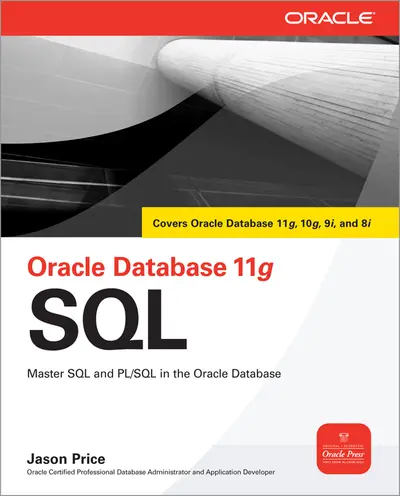My Account Details

ISBN10: 0071498508 | ISBN13: 9780071498500

Step 1 . Download Adobe Digital Editions to your PC or Mac desktop/laptop.
Step 2. Register and authorize your Adobe ID (optional). To access your eBook on multiple devices, first create an Adobe ID at account.adobe.com. Then, open Adobe Digital Editions, go to the Help menu, and select "Authorize Computer" to link your Adobe ID.
Step 3. Open Your eBook. Use Adobe Digital Editions to open the file. If the eBook doesn’t open, contact customer service for assistance.
Publisher's Note: Products purchased from Third Party sellers are not guaranteed by the publisher for quality, authenticity, or access to any online entitlements included with the product.
Write powerful SQL statements and PL/SQL programs
Learn to access Oracle databases through SQL statements and construct PL/SQL programs with guidance from Oracle expert, Jason Price. Published by Oracle Press, Oracle Database 11g SQL explains how to retrieve and modify database information, use SQL Plus and SQL Developer, work with database objects, write PL/SQL programs, and much more. Inside, you'll find in-depth coverage of the very latest SQL features and tools, performance optimization techniques, advanced queries, Java support, and XML. This book contains everything you need to master SQL.
- Explore SQL Plus and SQL Developer
- Use SQL SELECT, INSERT, UPDATE, and DELETE statements
- Write PL/SQL programs
- Create tables, sequences, indexes, views, and triggers
- Write advanced queries containing complex analytical functions
- Create database objects and collections to handle abstract data
- Use large objects to handle multimedia files containing music and movies
- Write Java programs to access an Oracle Database using JDBC
- Tune your SQL statements to make them execute faster
- Explore the XML capabilities of the Oracle Database
- Master the very latest Oracle Database 11g features, such as PIVOT and UNPIVOT, flashback archives, and much more
Chapter 2. Retrieving Information from Tables
Chapter 3. Using SQL *Plus
Chapter 4. Using Simple Functions
Chapter 5. Storing and Processing Dates and Times
Chapter 6. Subqueries
Chapter 7. Advanced Queries
Chapter 8. Changing Table Contents
Chapter 9. Users, Privileges, and Roles
Chapter 10. Creating Tables, Sequences, Indexes, and Views
Chapter 11. Introducing PL/SQL Programming
Chapter 12. Database Objects
Chapter 13. Collections
Chapter 14. Large Objects
Chapter 15. Running SQL Using Java
Chapter 16. SQL Tuning
Chapter 17. XML and the Oracle Database
Appendix: Oracle Data Types
Index
Need support? We're here to help - Get real-world support and resources every step of the way.